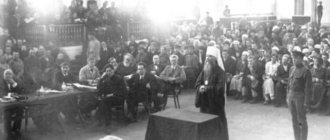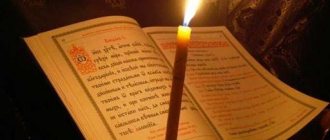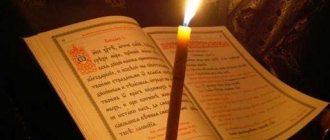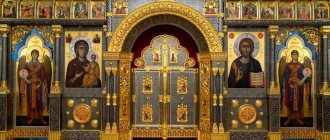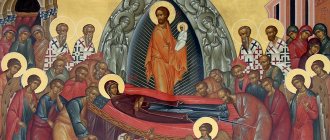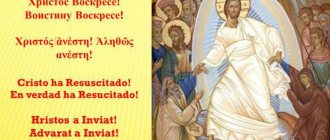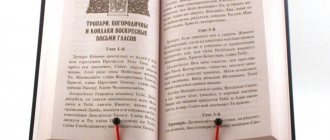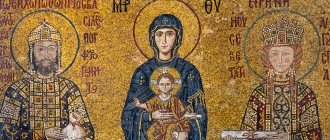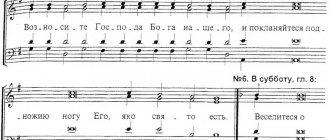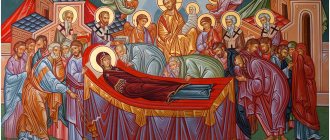Etymology
The word "kontakion" comes from the Greek κόνταξ ( kontax
), which means "rod" or "stick" and refers specifically to the pole around which the scroll is wound.[1] This term describes the way words in a scroll are unrolled when read. The word was originally used to describe an early Byzantine poetic form, the origins of which certainly go back to the sixth century AD, and possibly earlier. However, the term itself originates from the ninth century.[2]
There is also a collection of chants named after the genre of kontakion hymns, kondakarion
(Greek: κοντακάριον) or
Kondakar
(Church Slavonic: Kondakar).
In the kondakarion
it is not simply a collection of kontakia: in the traditions of the Conciliar Rite (as the rite practiced in the Hagia Sophia of Constantinople) it became the name of the book of prelude or lampadaria, also known as the "psaltikon", which included all the solo parts of the hymns performed during morning service and Divine Liturgy.
Since the Kontakia
usually sang protopsalts during the morning service, the first part of the morning service with its prokaymen and
Kontakia
was the longest part, so it was called simply
kontakarion
.
Icon from the Holy Roman Melodist singing his kontakion (1649, Malarita, Belarus).
When akathists are read in church
Many people, being in the temple for the first time, reading the church schedule, do not understand everything. For example, what is a prayer service with an akathist? They are served on special days. For example, before the New Year, the start of school. Believers can independently order prayer services - before the start of an important task, before leaving, on name day. If desired, this rite can be combined with an akathist and the blessing of water.
Only according to canonical rules, such a service is not allowed immediately after the Liturgy, because it is a shortened version of the evening service. Therefore, you should not insist on your own if the priest appoints a different time. Prayer services can be served not only in the church - you can invite the priest to your home, to an event, to the field (to bless the future harvest). Only a clergyman is allowed to serve it, but akathists are read freely by the laity.
- Water Blessing Prayer - what is it?
- Roman Sweet Singer - prayer, icon, troparion - find here
- Bell ringing to cleanse the home, soul and body -
Story
Kontakion was originally a Syriac form of poetry that became popular in Constantinople under Romanos Melodistos, Anastasios and Kyriakos in the 6th century and was continued by Sergius I of Constantinople and Sophronius of Jerusalem in the 7th century. Romanos's works were widely recognized as a decisive contribution to Byzantine hymnography, in some contacts he also supported Emperor Justinian by writing state propaganda.[3]
Kontakion of the novel On Christmas Day
also mentioned in his biography. Until the 12th century, it was sung annually at the imperial banquet on this holiday by the combined choirs of Hagia Sophia and the Church of the Holy Apostles in Constantinople. Much of the poem is a dialogue between the Virgin Mary and the Magi.[4]
Kontakion is a poetic form often found in Byzantine hymnography. It was probably based on Syriac hymnographic traditions, which were transformed and developed in Greek-speaking Byzantium. It was a homiletical genre and could best be described as “a sermon in verse accompanied by music.” It is similar in character to early Byzantine festival sermons in prose—a genre developed by A. Ephraim the Syrian—but the meter and music greatly enhanced the drama and rhetorical beauty of the speaker's often deep and very rich meditation.
Medieval manuscripts, which preserve about 750 kontakia from the 9th century, about two-thirds were composed from the 10th century, but these were rather liturgical works with two or six oikoi, each ending with a refrain identical to the introduction (prooimion). Longer compositions were Slavic akathists, inspired by the acrostic kontakion, whose 24 stanzas began with each letter of the alphabet (Akathist).
Within the cathedral rite, a truncated rite was developed, which reduced the kontakion to one oikos or simply to prooimion, and the music was reworked in a melismatic style. The classical repertoire consisted of 42 kontakia-idiomelas and 44 kontakia-prosomoia, composed of a limited number of model stanzas consisting of fourteen prooimia-idiomelas and thirteen okoia-idiomelas, which could be combined independently.[5] This classical repertoire was dominated by classical composers of the 6th and 7th centuries.
Form
The form usually consists of 18-24 metrically identical stanzas, called oikoi
("At home"), which is preceded in another meter by a short prelude called
Koukulion
(hood) or
prooimoion
. The first letters of each stanza form an acrostic, which often includes the poet's name. For example, Roman's poems often include the acrostic "On Modest Romances" or "The Poem of Modest Romances".[2] The last line of the prelude introduces a chorus called the "ethymnion", which is repeated at the end of all stanzas.
The main part of the kontakion was sung from the pulpit by the priest (often a deacon; otherwise the reader) after the reading of the Gospel, and the choir even the entire congregation joined in the chorus. The length of many kontakia - indeed, the epic nature of some - suggests that much of the text must have been presented in recitative form, but unfortunately the original music that accompanied the kontakia is now lost.[6]
Initial view
So, unlike modern ones, the ancient kontakia were distinguished by a large number of stanzas - from twenty to thirty, they were united by a single refrain, which was sung by the people. The canonarch read the stanzas. The first stanza was an introduction to the topic and was usually written in a specific syllable that was not repeated in the rest of the work, while the last part contained edifying instructions and was more like a prayer. Often the first letters of the lines formed a so-called acrostic - that is, a completely meaningful sentence.
Initially, kontakion was likened to a building consisting of many separate rooms, since “ikos” can be translated from Greek as “house”.
Liturgical place of kontakion
As part of the cathedral rite, the ritual context of the long kontakion was the pannichi
during ceremonial events (festive night vigil) and usually took place at the Blachernae Chapel.[7] Suggestions that kontakia replaced canonical poetry or, conversely, that the Stoudites replaced kontakia with Hagiopolitan canonical poetry have always remained controversial. Patriarch Germanus I of Constantinople had earlier founded their own local school (even if it is no longer in modern books), while the Studites embraced the kontakion genre with their new writings. The only explanation is that different customs must have existed simultaneously, a truncated and a long kontakion, but also a ritual context for both customs.
The truncated form consisted only of the first stanza, called "koukulion" (now called "kontakion"), and the first oiko, while the other oikos were omitted. Within the Orthros, the kontakion and oikos come after the sixth song of the canon; however, if the typikon since the day requires more than one kontakion at Matins, the kontakion and oikos of the more significant holiday are sung after the sixth ode, while those of the less significant holiday are moved to the place after the third ode, before the kathisma.[8][9]
From the end of the 13th century, when the Court and the Patriarchate returned from exile in Nikaya, the previous conciliar rite was not continued, which means that the previous celebration of kontakion also changed. The only thing celebrated throughout the kontakion was the Akathist Hymn. Its original location was on the feast of the Annunciation (March 25). In later kontakaries and oikematarions, which treated all 24 oikoi in a calophonic way, the Akathist was written as part of the triodion, within the oikematarion the complete kontakion took up half the volume of the entire book.[10] Thus, it could only be performed in short segments throughout Lent and became a kind of paraliturgical genre. In modern practice, this comes down to the irmological melos, which allowed the entire Akathist to be performed at the morning service of the fourth Sunday of Lent.[11][12] This Akathist has traditionally been attributed to Romanos, but recent scholarship has disapproved of this. In Slavic hymnography, the so-called akathist became an independent genre dedicated to various saints; although they are not part of any prescribed service, they can be prayed as hymns of prayer at any time.
Modern practice considers the kontakion to be a proper troparion based on the text of the prooimion dedicated to a particular feast of the meneon or mobile cycle.
When to read the Akathist
Prayer comes in different forms, first of all - church prayer, it is the most important, since all the church Sacraments are performed in the church, giving salvation to the soul. But there is also a home or cell room. At home, many believers like to read various akathists. What it is? This is a type of church poetry. If the name is translated from Greek, it indicates that you cannot sit while saying these prayers (for example, while reading kathisma, you can).
There are no church instructions on when it is necessary to turn to akathists. Every believer is free to read them according to the desire of his own soul. Usually they read one per week, or even daily - if you have enough spiritual strength. As a rule, they resort to this form of prayer when they want to pray for something serious:
- during illness;
- if you want to find a groom or conceive a child;
- when the wife wants her husband to stop drinking;
- about ending wars;
- They also ask for household needs.
Work as a courier at Yandex.Eda (up to 3,400 rubles per shift) leave a request →
What is reading akathists by agreement? It's very simple - people agree to read the same text at the same time. It so happens that, being in different places, they simultaneously offer their petitions to the Lord. The effect of such a reading will be much stronger than from a single one.
Promotion of 4 classic contacts
The examples chosen here are only the introduction (prooimion, koukoulion), and they belong to the old basic repertoire of 86 kontakia, which were all known as part of the conciliar rite. Thus, they can be found with designations in the kondakarion-psaltikon.[5]
According to the melodic system of the cathedral rite, certain kontakia-idiomela served as melodic models that were used to compose other kontakia. Kontakion for Easter, for example, was used to compose the Old Church Slavonic kontakion in honor of local saints. Boris and Gleb, two prince-martyrs of Kievan Rus. The final verse called "ephymnion" (ἐφύμνιον) was repeated as a refrain after each oikos, and its melody was used in all kontakia composed in the echos plagios tetartos.
Kontakion of Easter
(Easter)
Slavic kondakar has an old gestural designation that refers (in the first row) to hand gestures used by choirmasters to coordinate singers. With the exception of the ethymnion, the entire proimnion and oikoi were read by a soloist called "monofonaris" (the hand sign was not as important as during the ethymnion). The Middle Byzantine notations used in the Greek kontakarion-psaltikon rather show the melismatic melos behind these signs.
Easter kontakion Ashe and to the grave (Easter kontakion Εἰ καὶ ἐν τάφῳ) in echos plagios tetartos and its kontakion-prosomoion Ashe and killed quickly (July 24 Boris and Gleb) (RUS-SPb RS. Q.p.I.32, ET- MSsc RS Sin Gr 1280, F-Pn fonds grec Ms 397)
Εἰ καὶ ἐν τάφῳ κατῆλθες ἀθάνατε, ἀλλὰ τοῦ ᾍδου καθελες τὴν δύνα μιν, καὶ ἀνέστης ὡς νικητής, Χριστὲ ὁ Θεός, γυναιξὶ Μυροφόροις φθεγ ξάμενος. Χαίρετε, καὶ τοῖς σοῖς Ἀποστόλοις εἰρήνην δωρούμενος ὁ τοῖς πεσο ῦσι παρέχων ἀνάστασιν.
Even in the tomb, immortality in hell has been destroyed, and in the morning, Christ the victorious God, to the wives of the muron bearers, the joy of the prophet and to his apostles, peace is given to the fallen upon resurrection
[13]
Although You descended into the grave, O Immortal One, yet You destroyed the power of Hades, and O God Christ rose in victory, calling to the myrrh-bearer: Rejoice! and granting peace to Thy apostles, Thou who grantest resurrection to the fallen.
[14]
Another example, composed of the same echoes, is the Akathist Hymn, originally intended for the Feast of the Annunciation (nine months before the Nativity of Christ).
Kontakion of the Annunciation of the Blessed Virgin Mary
(March 25)
ὑπερμάχῳ στρατηγῷ τὰ νικητήρια, ὡς λυτρωθεῖσα τῶν δεινῶν εὐχ αριστήρια, ἀναγράφω σοι ἡ πόλις σου, Θεοτόκε · ἀλλʹ ὡς ἔχουσα τὸ κράτ ?? Αῖρε Νύμφη ἀνύμφευτε.
The elected voivod is victorious, and in order to extinguish and thank you, write this city down to the Mother of God for the sake of the invincible and all the troubles of freedom and may you call for the sake of it The bride is not the bride.
[15]
To you, leader of champions, we, your servants, dedicate the holiday of victory and thanksgiving as those saved from suffering, Mother of God; but as you are one with invincible power, deliver us from all the dangers that may exist, and we will cry to you: Rejoice, Celibate Bride.
[14]
Kontakion of the Transfiguration of the Lord
(August 6)
This kontakion-idiomelon of Roman Melodist was composed in echos varys (grave mode), and the prooimion was chosen as a model for the prosoimion resurrecting kontakion Ἐκ τῶν τοῦ ᾍδου πυλῶν in the same echoes.
Ἐπὶ τοῦ ὄρους μετεμορφώθης, καὶ ὡς ἐχώρουν οἱ Μαθηταί σου, τὴν δό ξαν σου Χριστὲ ὁ Θεὸς ἐθεάσαντο · ἵνα ὅταν σὲ ἴδωσι σταυρούμενον, τὸ μὲν πάθος νοήσωσιν ἑκούσιον, τῷ δὲ κόσμω κηρύξωσιν, ὅτι σὺ πάρχει ς ἀληθῶς, τοῦ Πατρὸς τὸ ἀπαύγασμα.
On the mountains, it is aimed and ꙗKo ѹ your famaches is your glorious god of God, yes it is ѹ ѹ ѹ ѹ ѹ ѹ a passion ѹ more time, I am a miracle ѹ ѥ ѥi in the truth
[16]
On the mountain You (sic) were transfigured, and Your disciples, as much as they could bear, saw Your glory, O Christ God; so that when they see You crucified, they would know that Your passion will desire, and would preach to the world that You are truly the Radiance of the Father.
[14]
Kontakion of the Sunday of the Prodigal Son
(9th week before Easter, 2nd week of triodion)
The last example is not a model, but a kontakion-prosomoion, which was composed to the melody of Kontakion παρθένος παρθένο σ inμερον in the echos tritos of Romanus the Melodist.[17]
Τῆς πατρῴας, δόξης σου, ἀποσκιρτήσας ἀφρόνως, ἐν κακοῖς ἐσκόρπισα, · Ἥμαρτον ἐνώπιόν σου Πάτερ οἰκτίρμον, δέξαι με μετανοοῦντα, καὶ ποίησ όν με, ὡς ἕνα τῶν μισθίων σου.
Foolishly, having abandoned Your fatherly glory, I squandered the wealth that You gave me on vices. Therefore, I cry to You with the voice of the prodigal son: I have sinned before You, merciful Father. Receive me as one who has repented, and make me one of Your hired servants.
[14]
Notes
- Mpampiniotis, Georgios (1998). Lexiko tis neas ellinikis glossas (Dictionary of Modern Greek - in Greek)
. Athens: Kentro lexikologias. - ^ a b
Gador-White, Sarah (2017).
Theology and Poetry in Early Byzantium: The Kontakia of Romanus the Melodist
. Cambridge: Cambridge University Press. pp. 9–11. ISBN 9781316492512. OCLC 992462921. - Regarding the opening of Hagia Sophia, see Johannes Coder (2008).
- The visit of the Magi to the newborn baby is celebrated in the Orthodox Church on December 25, and not on January 6. The Feast of Epiphany on January 6 celebrates the Baptism of Christ in the Orthodox Church).
- ^ a b
See edition by Constantine Floros (2015). - Lash, Archimandrite Ephraim (1995). Holy Roman Melodist, On the Life of Christ: Contacts
. San Francisco: Harper. pp. 1–12. - Alexander Lingas (1995).
- Liturgics Archived 2011-07-26 on the Wayback Machine, section “Singing the Troparians and Contacts,” Accessed January 17, 2012.
- Tvpikon, pp. 7, 11, 12, etc.
- See Oikematarion, written on Mona Esphigmenu (ET-MSsc RS. Sin. gr. 1262, ff.67v-131r).
- Liturgics Archived 2011-07-26 on the Wayback Machine, section "Fourth Sunday of Lent", accessed January 17, 2012.
- Tvpikon, page 437
- Quoted from the Blagoveshchensk Condakar (RUS-SPb RS. Q.p.I.32, f. 66).
- ^ a b c d
Translation according to the Prayer Book published by Holy Trinity Monastery (Jordanville, New York). - Quoted from the Blagoveshchensk Condakar (RUS-SPb RS. Q.p.I.32, f. 36v-37r).
- Quoted from the Typographical Charter (RUS-MGT K-5349, f.75v-76r). Edited by Boris Uspensky (2006).
- For other prosomo contacts of the same model, read the article Idiomelon.
Recommendations
- Archbishop Averky († 1976); Archbishop Laurus (2000). "Liturgy". Holy Trinity Orthodox School, Russian Orthodox Church Abroad, 466 Foothill Blvd, Box 397, La Canada, California 91011, USA. Archived from the original on July 26, 2011. Retrieved January 15, 2012.
- Tvpikon sіest ustav (The title here is translated into Russian; actually in Church Slavonic) (Typikon, which is an Order)
, Moscow (Moscow, Russian Empire): Сvnodal'naya tvpography (Synodal Printing House), 1907. - Floros, Constantine (2015). Das mittelbyzantinische Kontaktienrepertoire.
Untersuchungen und kritische Edition .
1–3
. Hamburg (received his bachelor's degree in 1961 from the University of Hamburg).CS1 maint: location (link to website) - Floros, Constantine; Neil K. Moran (2009). The Origins of Russian Music - An Introduction to Kondakarian Notation
. Frankfurt, M. [ua]: Lang. ISBN 978-3-631-59553-4. - Koder, Johannes (2008). "Imperial Propaganda in the Kontakia Roman Melody". Dumbarton Oaks Papers
.
62
: 275–291, 281. ISSN 0070-7546. JSTOR 20788050. - Lingas, Alexander (1995). "The place of the kontakion liturgy in Constantinople." In Akentyev, Konstantin S. (ed.). Liturgy, architecture and art of the Byzantine world: Materials of the XVIII International Byzantine Congress (Moscow, August 8–15, 1991) and other essays dedicated to the memory of Fr.
John Meyendorff .
Byzantino Rossica. 1
. Saint Petersburg. pp. 50–57.
Sources
- “Sinai, St. Catherine's Monastery, Mrs. Gr. 925". Kontakarion without notes, organized as menaion, triodion (at least in part) and pentekostarion (10th century)
. - "St. Petersburg, Russian National Library, Ms. Q.p.I.32." Nizhny Novgorod kondakar of the Annunciation Monastery, presented, described and transcribed by Tatiana Shvets (circa 1200)
. - "Paris, National Library of France, Greek Foundation, Mrs. 397." Incomplete kondakarion (Prokeimena, Stichologia for Christmas and Theophany, Allelouiaria, Hypakoai anastasima, kontakia) in the style of short psaltikon with Middle Byzantine round notation (late 13th century)
. - “Sinai, St. Catherine's Monastery, Mrs. Gr. 1280". Psaltikon (Prokeimena, Allelouiaria, Hypakoai, Anti-cherouvikon for the liturgy of the Presanctified Gifts) and Kontakarion (menaion with integrated movable cycle) with Middle Byzantine round notation written in a monastic context (c. 1300)
. - “Sinai, St. Catherine’s Monastery, Mrs. Gr. 1314". Psaltikon-Kontakarion (prokeimena, allelouiaria, kontakarion with embedded hypakoai, hypakoai anastasima, complete hymn of Akathistos, kontakia anastasima, stichera heothina, appendix with alleluaria refrains in the 14th century octoechos Nephophyte), written by the monk octoechos neophyte (14th century)
. - “Sinai, St. Catherine's Monastery, Mrs. Gr. 1262". Oikematarion kalophonikon, based on the Papadian writings of Michael Aneotos and the kalopismoi of Ioannis Glykis, copied by Gregorios Monachos in Mone Esphigmenou on Mount Athos (1437)
.
Editorial staff
- Uspensky, Boris Alexandrovich, ed. (2006). Typographical Charter: Charter with Kondakar of the late XI - early XII century [Typographical Charter: Charter with Kondakar late XI - early XII centuries.
(vol. 1: facsimile, vol. 2: publication of texts, vol. 3: monographic essays)] .
Monuments of Slavic-Russian writing. New episode. 1–3
. Moscow: Languages of Slavic cultures. ISBN 978-5-9551-0131-6.
